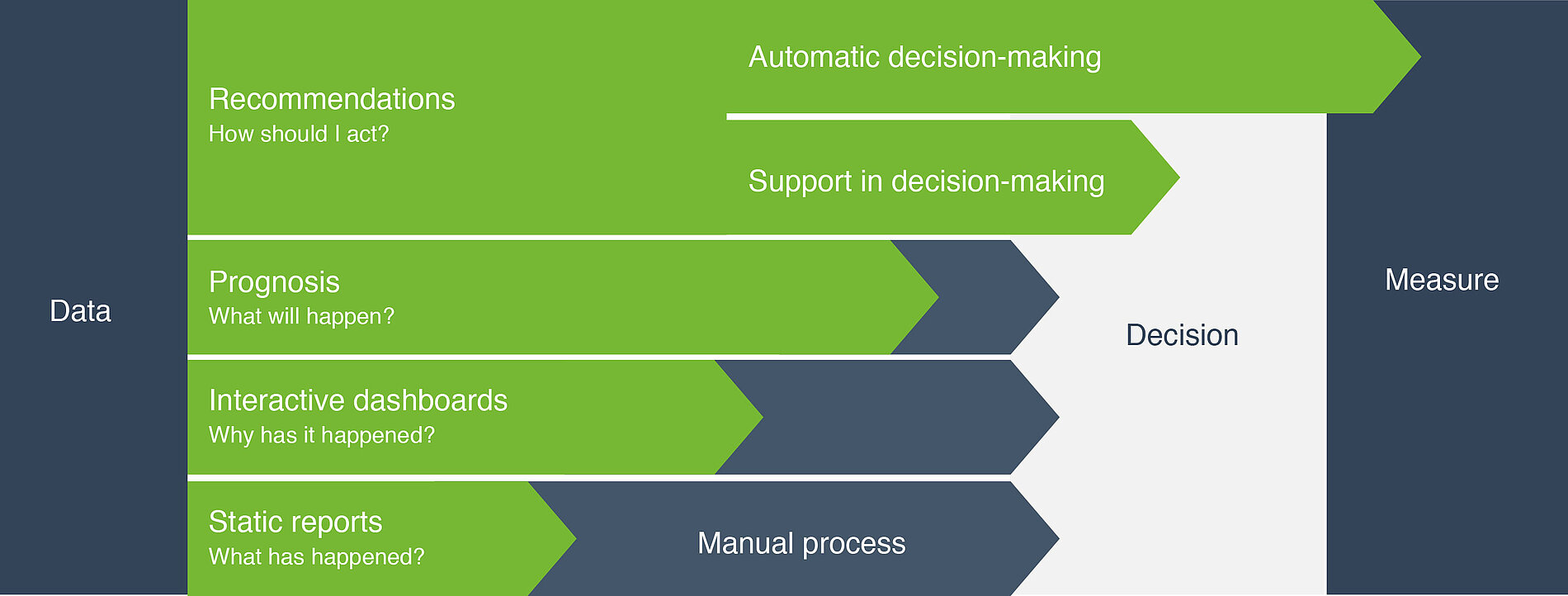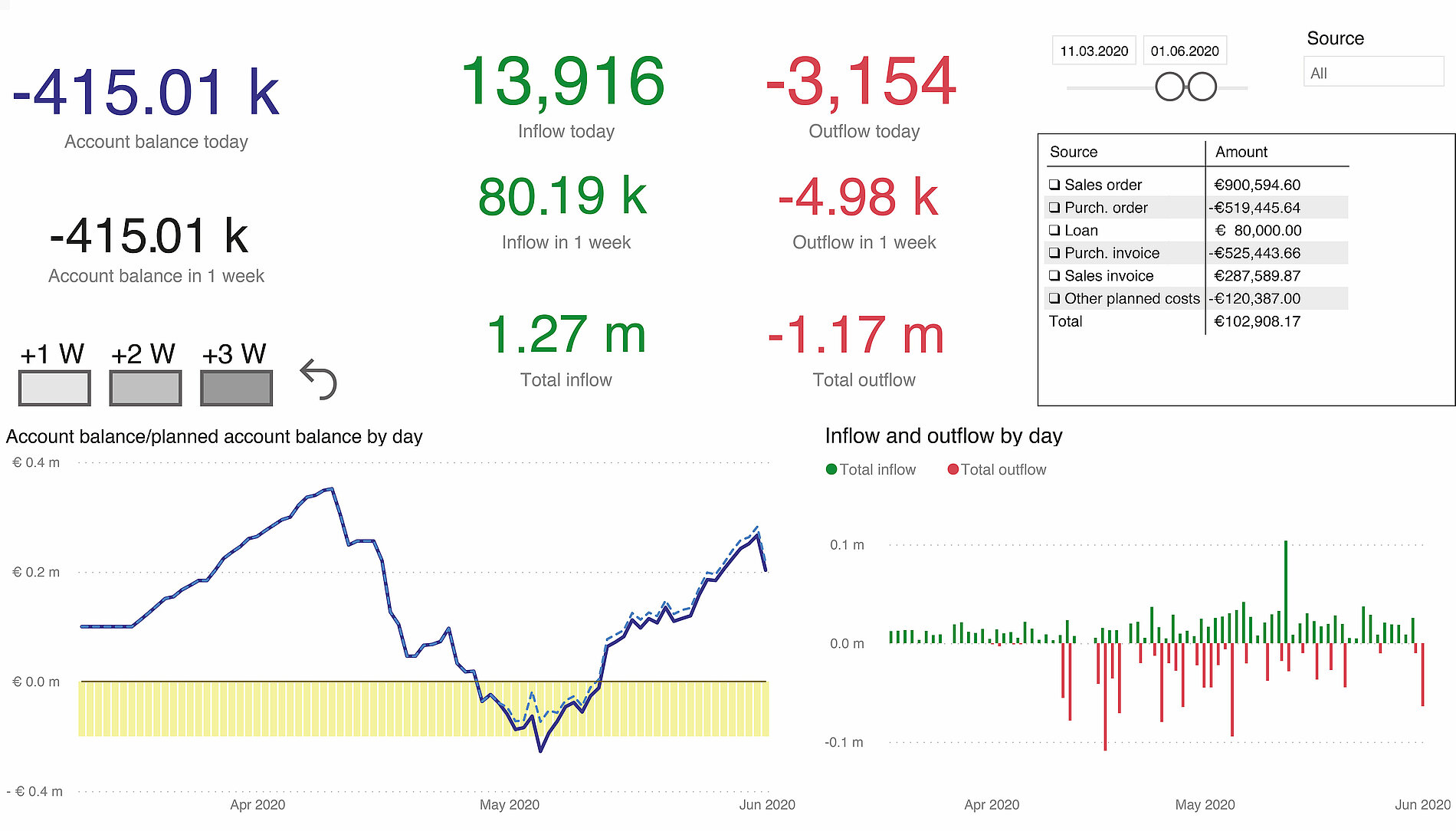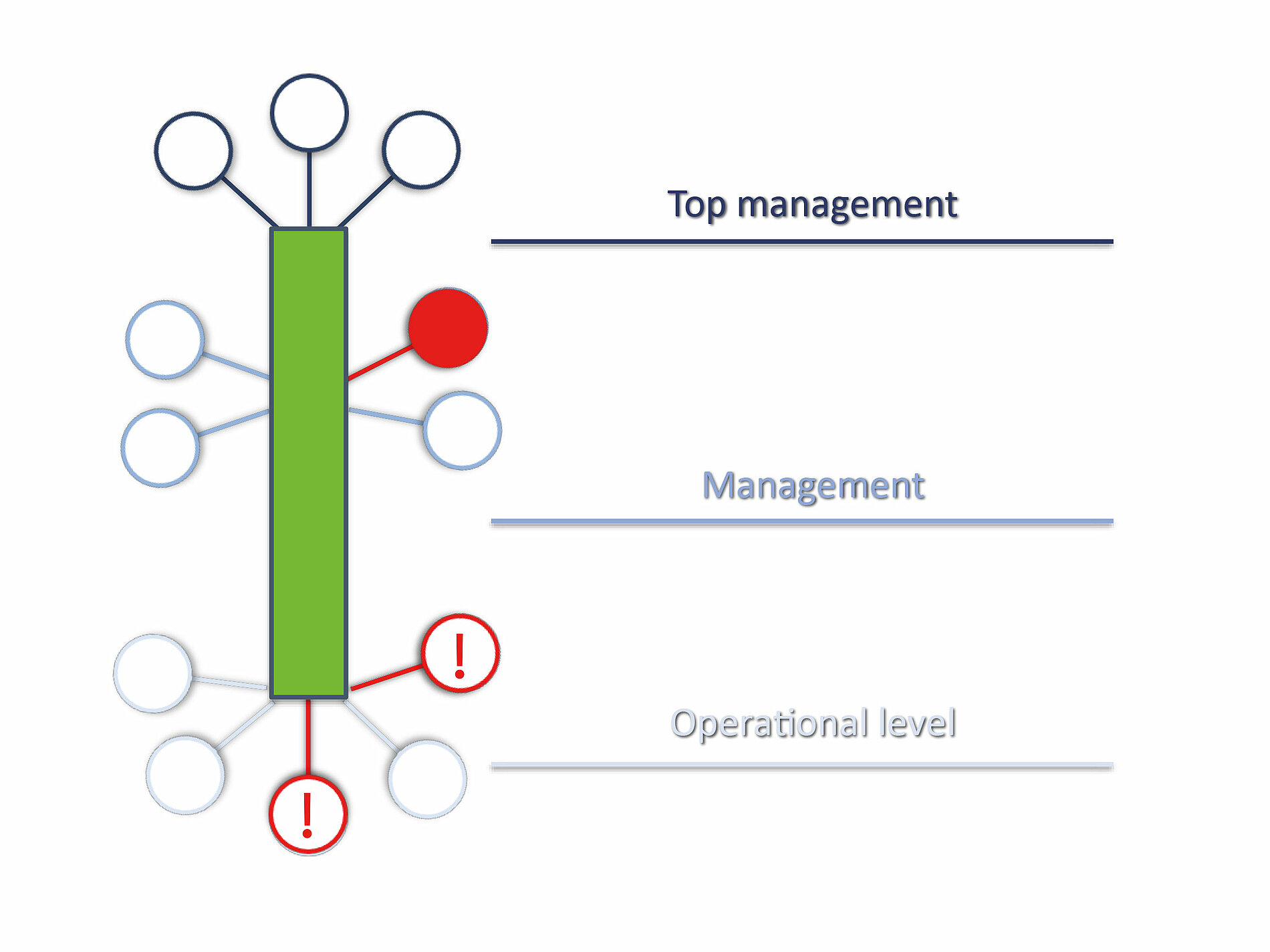Data analytics - Support for management decisions in times of crisis
DLG Expert Report 02/2021
Author:
Boris Fischmann, CEO – NoseDat GmbH
boris.fischmann@nosedat.com
in cooperation with the DLG Competence Center Food
Inhalt
- 1. Initial situation
- 2. Duties of due care
- 2.1 Organisational duty
- 2.2 Embezzlement
- 3. Insolvency – merely a temporary respite due to the German Act to Temporarily Suspend the Obligation to File for Insolvency and to Limit Directors’ Liability in the Case of Insolvency Caused by the COVID-19 Pandemic (COVInsAG)
- 3.1 Initial situation concerning the obligation to file for insolvency
- 3.2 Respite due to the German Act to Temporarily Suspend the Obligation to File for Insolvency and to Limit Directors’ Liability in the Case of Insolvency Caused by the COVID-19 Pandemic (COVInsAG)
- 4. Business intelligence (BI) as a control instrument for managing directors
- 4.1 Data warehouse (DWH) and business intelligence (BI) as intelligent information aids
- 4.1.1 Manual decision-making process
- 4.1.2 Supporting decision-making
- 4.1.3 Automatic decision-making
- 4.2 Intelligent control in liquidity planning
- 5. Necessary content in the sense of a transparency concept
- 6. Summary and résumé
- Sources
- Kontakt
1. Initial situation
The current coronavirus situation is presenting managing directors and management board members with major challenges in their daily work routines. Work-from-home regulations have changed the way in which we work dramatically, and many employees are completing their daily tasks from their homes. This leads to considerable difficulties in terms of communication and checking the agreed goals. Managing directors are additionally responsible for adherence to regulations (compliance) even when staff are working from home.
Another crucial aspect, however, is the establishment of structures that enable them to identify the economic and financial situation of the company as well as the related risks at all times in order to comply with their organisational duties.
The following Expert Knowledge Series issue is aimed at specifically showing the critical duties of managing directors and management board members in the coronavirus crisis. It also provides an explanation of the options available for achieving the transparency necessary in day-to-day business so that managers can obtain an optimum overview of the company’s operational and financial status.
2. Duties of due care
2.1 Organisational duty
In accordance with Section 43 of the German Limited Liability Companies Act (GmbH-Gesetz), managing directors must conduct the company’s affairs with the due care of a prudent businessman. If they fail to do so and breach the duties incumbent upon them, they are jointly and severally liable to the company for any losses that occur. This is attributable to their managing position and the administration of third-party financial interests. As part of their organisational duty, managing directors are therefore required to establish structures that enable them to identify the economic and financial situation of the company as well as the related risks at all times.
Specifically, this means that the management board member of a publicly limited company/the managing director of a limited liability company ensures that the company and its employees comply with all of the regulations that pertain to the company.
Compliance is of overarching importance, especially in times of crisis. In particular, control measures should focus on compliance with statutory data protection responsibility in connection with working from home or risks due to cyber criminality as a result of inadequate protection components.
What are called ‘fraud risks’ also increase significantly, especially in times of crisis. The reasons why employees engage in these fraudulent activities are diverse: besides manipulating sales figures to ensure their annual bonus, one of the main causes is also often the fear of losing their income, their job or their standing. Particularly in times of crisis, managing directors must therefore have access to valid and harmonised figures that virtually rule out such conduct and bring irregularities to light.
2.2 Embezzlement
A managing director who fails to keep the company’s economic situation in sight 100% in times of crisis can quickly become liable to prosecution for embezzlement in accordance with Section 266 of the German Criminal Code (StGB). This can be due, for example, to:
- the illegal distribution of bonus payments
- advance payments to contractual partners that no longer reveal the necessary solvency and whose returns are not adequately secured
This is attributable to the duty of safeguarding and looking after the financial interests of third parties (e.g. owners).
In particular, it must be noted that the ‘procedural reversal of the burden of proof’ comes into play in such cases. This means that, in deviation from the German constitution, the management must prove in this case that it has complied with its duty of due care and has therefore ‘acted according to the letter of the law’. In accordance with the German constitution, the claimant must normally prove the facts on which the claim is based, but the reverse is true in this case.
3. Insolvency – merely a temporary respite due to the German Act to Temporarily Suspend the Obligation to File for Insolvency and to Limit Directors’ Liability in the Case of Insolvency Caused by the COVID-19 Pandemic (COVInsAG)
3.1 Initial situation concerning the obligation to file for insolvency
The fundamental parameters for instituting insolvency proceedings in accordance with the German Insolvency Statute (InsO) are again outlined as an introduction.
Firstly, this involves the classic insolvency as outlined in Section 17 InsO. According to practical experience, it can be assumed that insolvency has occurred if 10% of the total liabilities that are due cannot be covered within the next three weeks.
The second reason is overindebtedness in accordance with Section 19 InsO. This is the case if the assets no longer cover the existing liabilities and there is no positive forecast for the continued existence of the company in the sense of sustainable financing.
It results from this that insolvency must be filed for within three weeks of the occurrence of insolvency or overindebtedness at the latest.
3.2 Respite due to the German Act to Temporarily Suspend the Obligation to File for Insolvency and to Limit Directors’ Liability in the Case of Insolvency Caused by the COVID-19 Pandemic (COVInsAG)
The basic idea behind the COVInsAG is to counteract the economic effects of the pandemic. It deals particularly with the possibility of the continued existence of companies despite financial difficulties.
The most important element to be mentioned with respect to the obligation to file for insolvency involves the possibility that companies are not compelled to do so despite the existence of the aforementioned reasons for insolvency.
The objective of this is to give companies the time to develop alternatives. These can include state aid as well as agreements with creditors and financial backers in order to coordinate financing agreements and restructuring.
In many cases, however, it is to be anticipated that the application of the German Act to Temporarily Suspend the Obligation to File for Insolvency and to Limit Directors’ Liability in the Case of Insolvency Caused by the COVID-19 Pandemic will only delay the onset of insolvency and that the managing directors will subsequently be under the same obligations as would have been the case without the COVInsAG.
On the basis of corresponding structures, the management must therefore always be in a position that gives it an overview of the company’s financial situation. This particularly includes the following points:
- Financial status for determining liquidity on the cut-off date
- Financial plan for multi-week liquidity planning
- Close monitoring of payment and service transactions
In detail, this equates to a need for high transparency regarding operational and financial accounting issues. Introducing comprehensive ‘reporting & dashboarding’ in the context of business intelligence has proved worthwhile in practice.
4. Business intelligence (BI) as a control instrument for managing directors
Numerous systems that contain important information for managing directors’ and managers’ decisions are in use in many companies. Usually, however, these systems are interlinked either inadequately or not at all, and do not provide an overall overview or show the dependency of processes.
If a customer has already exceeded its payment targets and places additional orders, for example, order entry itself should trigger an alarm indicating that corresponding actions ought to be implemented in this case.
The same also applies to production plans that are linked to contracts and cannot be adhered to as a result of raw material purchasing bottlenecks. Automated messages should also immediately lead to corresponding measures in the sales department in this case as well.
Managers and employees are only enabled to act proactively and implement appropriate countermeasures through the establishment of this level of transparency across multiple processes and systems.
4.1 Data warehouse (DWH) and business intelligence (BI) as intelligent information aids
The main task of a data warehouse is to harmonise and validate data from diverse systems and to process it as required. ‘As required’ means that the right key performance indicators (KPIs) are available for the right process at the right time.
Only this ensures that employees are able to make the right decisions on the basis of targeted information.
Various forms of possible support can potentially be used in this context:
4.1.1 Manual decision-making process
In this process, the necessary basic information that represents the basis for decision-making is shown to a manager or an employee. Which decision is made is dependent on various individual factors in this case, including the competence, the experience and the speed of the person authorised to make the decision. In practice, it is often the case that significant differences in decision-making can occur due to diverse individual factors. Despite this disadvantage, this method is still preferable to decision-making that is not based on valid information.
4.1.2 Supporting decision-making
In this process, several options are suggested to the decision-makers by the data warehouse. In part, these suggested values can be based on very extensive and complex circumstances that a human being may possibly no longer be able to grasp.
The ordering suggestion could be determined optimally if, for instance, sales are estimated in the sense of a sales prediction in the scheduling department, repurchasing times and market prices are taken into consideration and weather and trend data from social networks is factored in. Ideal parameters within which they can operate are specified to the schedulers.
4.1.3 Automatic decision-making
The third expansion stage is achieved when processes are carried out entirely automatically. To stick to the aforementioned example, an ordering process would be undertaken by the system without a manual check.
Of course, enterprise resource planning (ERP) systems themselves can also determine simple ordering suggestion types. However, a data warehouse determines more extensive and accurate data, since a broader and more relevant data basis is available to it. The resulting ordering suggestions from the data warehouse can then be transferred to the ERP system for operational implementation.
This is only one of many examples of how business intelligence can support operational processes. In-depth process analysis often reveals optimisation potentials with various degrees of efficiency in terms of cost, time and personnel savings.
Fig. 2 again shows the above described development stages and possible application areas schematically.
4.2 Intelligent control in liquidity planning
BI solutions can be used with high added value not only in the operational area, but also specifically in financial management. Daily, automatic projections and scenarios provide the decision-makers with the transparency and certainty necessary to underpin their actions and withstand possible audits by investors, auditors or shareholders.
The following shows an example of a dashboard in which decision-makers can see the current status of the company’s liquidity and its future progression at a glance.
The current liquidity can be visualised in any company on the basis of financial accounting. The complexity arises from forecasting future incoming and outgoing payments as precisely as possible in order to achieve planning security for the coming weeks and months. Only this overview enables companies to conduct talks with banks, suppliers and investors at an early stage.
The sales data can be cited as an example of integrating operational data into liquidity planning. In this process, customer purchase orders are evaluated with the confirmed delivery date and placed into relationship with the customer’s actual payment behaviour based on its historic data. A prognosis regarding when the payment will be received in the future is therefore obtained on receipt of the order and can be taken into consideration in liquidity planning. This procedure can equally be used for supplier purchase orders, loans and other company costs.
Im Fokus sollten dabei folgende Inhalte stehen:
- Actual liquidity ➡ data are transformed into a time-based liquidity overview:
- Incoming and outgoing invoices
- Outstanding orders and purchase orders
- Personnel costs
- Tax burdens
- Lines of credit and borrowing, interest, repayments
- Etc.
- Planned liquidity
- Planning masks that can be quickly configured to incorporate changes/adjustments/planning - Measure management
- Systemic recording and management of measures to ensure performance
- Prioritisation of the measures and measurement of success including a suggestion system for future decisions
This visualisation can be supplemented with scenarios such as a 1- to 3-week delay in payment by a supplier.
The impact on the company’s liquidity situation would be immediately visible and appropriate steps would be possible.
5. Necessary content in the sense of a transparency concept
One of the most important tasks of a BI system is to establish a ‘stage’ that offers the various company levels a discussion and decision-making platform. As a result of this, the management and top management levels are able to engage in dialogue on the basis of central, homogeneous and reliable KPIs. If a ‘red light’ comes on on one of the levels, all of the parties involved can immediately see the effects, and measures can be jointly developed.
Figure 4 schematically shows the communication paths of dependent key performance indicators across the various levels in a company. If a KPI runs out of control on the operational level, for example, this is immediately indicated on the management dashboard. Both levels are therefore able to counteract this deviation.
In order to make optimum use of this potential, the company should become a ‘KPI-driven company’ in which all important decisions can be made and accordingly communicated on the basis of key performance indicators. To achieve this objective, key performance indicators must be broken down to an appropriate level of detail by the top management.
The evaluation hierarchy of a production company from the dairy industry can be cited as an example here.
| Top management: | Overall equipment efficiency (OEE) |
| Management: | Equipment efficiency (EE) |
| Standstill clusters | |
| Rejection reasons | |
| Output | |
| Nominal output | |
| Operational level: | Standstill details |
By rigorously tracking the consistency of KPIs, the company additionally achieves the following advantages:
- Dependencies can be recognised immediately
- Transparency, understanding and a sense of responsibility are increased
- Uniform presentation and communication level
- Target discussions and continuous nominal/actual comparison are possible
- Quality increase on the part of each individual employee thanks to a specified analysis path
- Standardisation through adherence to the most important analysis tasks
Training the employees in the use of the key performance indicators is an important requirement for the successful operational use of such a system. This includes not only explaining the content of a KPI, but also its correct interpretation. Introduction and the familiarisation of new employees can be structured more efficiently by means of clearly arranged and easily understandable key performance indicator handbooks that are set out according to processes.
6. Summary and résumé
As has been exhaustively explained in this Expert report text, it is the task of the senior management and the management board to remain abreast of the company’s financial situation at all times. This refers both to the operational levels and to financial accounting with integrated liquidity planning.
Practical experience has shown that this expectation can only be met by means of consistent reporting in the sense of business intelligence on the basis of a structured data warehouse. The continuous availability of valid data ensures that the need for information can be met at all times. This means that decision-makers have a documented and sustainable supply of information with which they can comply with their supervisory obligations.
Sources
- www.gesetze-im-internet.de
- German Limited Liability Companies Act https://www.gesetze-im-internet.de/gmbhg/ (called up: 21.12.2020)
- German Criminal Code https://www.gesetze-im-internet.de/stgb/ (called up: 21.12.202)
- Act to Temporarily Suspend the Obligation to File for Insolvency and to Limit Directors’ Liability in the Case of Insolvency Caused by the COVID-19 Pandemic https://www.gesetze-im-internet.de/covinsag/ (called up: 21.12.2020)
- Insolvency Statute https://www.gesetze-im-internet.de/inso/ (called up: 21.12.2020)
Kontakt
Simone Schiller • Geschäftsführerin DLG-Fachzentrum Lebensmittel • Tel: +49(0)69/24 788-390 • S.Schiller@DLG.org






